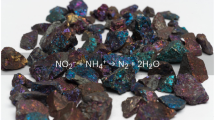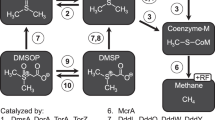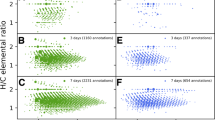Abstract
Organosulphur compounds constitute a significant fraction of organic matter in both recent and ancient iron-poor marine sediments as well as in petroleum generated in such sediments1,2. Most studies on organosulphur compounds in marine sediments have focused on hydrophobic compounds, for example, thiophenes3–6, sulphur-containing hopanoids7 and volatile compounds. Recently, hydrophilic, organic thiols were found in significant concentrations in anoxic marine sediments8,9. Several studies10–13 have shown that H2S formed from bacterial sulphate reduction can become incorporated into organic matter during early diagenesis, however, the exact chemical mechanisms by which this sulphur reacts with sedimentary organic matter are not well understood. Here we describe the widespread occurrence of 3-mercaptopropionic acid in coastal marine sediments (Biscayne Bay, Florida) and present evidence for its formation by an abiotic reaction between hydrogen sulphide and acrylic acid, which is a cleavage product of the common algal osmolyte β-dimethylsulphoniopropionate14,15. The reaction probably occurs by nucleophilic addition of bisulphide (HS−) ion to the activated double bond in the α,β-unsaturated car bony 1 system of acrylic acid. Reactions between hydrogen sulphide and activated unsaturated bonds in organic molecules are probably responsible for the formation of other thiols in sediments and could represent a major pathway for the incorporation of sulphur into sedimentary organic matter during early diagenesis.
This is a preview of subscription content, access via your institution
Access options
Subscribe to this journal
Receive 51 print issues and online access
$199.00 per year
only $3.90 per issue
Buy this article
- Purchase on Springer Link
- Instant access to full article PDF
Prices may be subject to local taxes which are calculated during checkout
Similar content being viewed by others
References
Tissot, B. P. & Welte, D. H. Petroleum Formation and Occurrence (Springer, Berlin, 1984).
Gransch, J. A. & Posthuma, J. in Advances in Organic Geochemistry 1973 (eds Tissot B. & Bienner F.) 727–739 (Technip, Paris, 1974).
Brassel, S. C., Lewis, C. A., de Leeuw, J. W., de Lange, F. & Sinninghe Damste, J. S. Nature 320, 160–162 (1986).
Sinninghe Damste, J. S., ten Haven, H. L., de Leeuw, J. W. & Schenck, P. A. Org. Geochem. 10, 791–805 (1986).
Sinninghe Damste, J. S., Kock-van Dalen, A. C., de Leeuw, J. W. & Schenck, P. A. Tetrahedron Lett. 28, 957–960 (1987).
Sinninghe Damste, J. S. et al. 51, (in the press).
Valisolalao, J., Perakis, N., Chappe, B. & Albrecht, P. Tetrahedron Lett. 25, 1183–1186 (1984).
Luther, G. W. III, Church, T. M., Scudlark, J. R. & Cosman, M. Science 232, 746–749 (1986).
Mopper, K. & Taylor, B. F. in Organic Marine Chemistry ACS Symposium Series 305 (ed. Sohn, M. L.) 324–339 (Am. Chem. Soc, Washington DC, 1986).
Sinninghe, J. S. & de Leeuw, J. W. Int. J. Environ. Analyt Chem. 28, 1–19 (1987).
Francois, R. Geochim cosmochim, Acta 51, 17–27 (1987).
Aizenshtat, Z., Stoler, A., Cohen, Y. & Nielsen, H. in Advances in Organic Geochemistry 1981 (eds Bjorøy, M. et al.) 279–288 (Wiley, Chichester, 1983).
Casagrande, D. J. et al. Nature 282, 559–600 (1979).
Charlson, R. J., Lovelock, J. E., Andreae, M. O. & Warren, S. G. Nature 326, 655–661 (1987).
Vairavamurthy, A., Andreae, M. O. & Iverson, R. L., Limnol. Oceanogr. 30, 59–70 (1985).
Ruegg, U. Th. & Rudinger, J. in Methods of Enzymology XLVII (eds Hirs, C.H.W. & Timashefi, S. N.) 111–116 (Academic, New York, 1977).
Mopper, K. & Delmas, D. Analyt. Chem. 56, 2558–2560 (1984).
Newton, G. L., Dorian, R. & Fahey, R. C. Analyt. Biochem. 114, 383–387 (1981).
Jørgensen, B. B. Limnol. Oceanogr. 22, 814–832 (1977).
Morrison, R. T. & Boyd, R. N. Organic Chemistry (Allyn and Bacon, Massachusetts, 1987).
Bergmann, E. D., Ginsburg, D. & Pappo, R. in Organic Reactions Vol. 10 (eds Adams, R. et al.) 179–555 (Wiley, New York, 1959).
Gershbein, L. L. & Hurd, C. D. J. Am. chem. Soc. 69, 241–242 (1947).
Dinur, D., Spiro, B. & Aizenshtat, Z. Chem. Geol. 31, 37–51 (1980).
Author information
Authors and Affiliations
Rights and permissions
About this article
Cite this article
Vairavamurthy, A., Mopper, K. Geochemical formation of organosulphur compounds (thiols) by addition of H2S to sedimentary organic matter. Nature 329, 623–625 (1987). https://doi.org/10.1038/329623a0
Received:
Accepted:
Issue Date:
DOI: https://doi.org/10.1038/329623a0
This article is cited by
-
Two Fe mining sub-products and three thiol compounds alleviate Fe deficiency in soybean (Glycine max L.) grown in a calcareous soil in greenhouse conditions
Plant and Soil (2023)
-
Watershed influences on mercury in tributaries to Lake Ontario
Ecotoxicology (2020)
-
Determination of picomolar levels of methylmercury complexes with low molecular mass thiols by liquid chromatography tandem mass spectrometry and online preconcentration
Analytical and Bioanalytical Chemistry (2020)
-
Organic carbon burial during OAE2 driven by changes in the locus of organic matter sulfurization
Nature Communications (2018)
-
Determination of dissolved and particulate thiols in Lake Biwa water and extracted fulvic acids by solid phase extraction followed by HPLC with fluorescence detection
Limnology (2018)
Comments
By submitting a comment you agree to abide by our Terms and Community Guidelines. If you find something abusive or that does not comply with our terms or guidelines please flag it as inappropriate.



